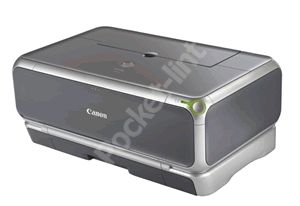Canon's iP4000 is one of several new PIXMA printers from Canon, styled to look like anonymous cubes of shiny black slate, edged with silver grouting. The company has dubbed PIXMA its 'designer' brand. Its appeal is that it prints photos and documents well without making your home look like the local branch of Prontaprint.
Our quick take
This good value printer should be popular with home users. It handles two everyday, essential print jobs - photos and documents - as well as being designed to fit snugly onto a bookshelf. We don't think PIXMA will become the design icon that the company's IXUS cameras are, but Canon has started the ball rolling and there should be plenty more colourful printers in the future from all the manufacturers.

Canon PIXMA iP4000 - 4.0 / 5
| FOR | AGAINST |
|---|---|
|
|
The iP4000 has some clever, new design features like the addition of a paper cassette that fits under the printer and feeds paper in to do a complete U turn and reappear in the drop down tray on the front of the printer. This means the printer needs very little head room so it can be used in a fitted cabinet or on a book shelf. If you prefer your printer sitting on your desk, there is a traditional sheet feeder that fits on top of the machine. With both paper trays attached, one can be loaded with plain paper and the other with photo print media so there is less need to stop and swap paper depending on what you are printing. The U turn tray works less well with A4 because it has to be extended to take the paper and so sticks out beyond the front line of the printer which spoils the minimalist lines of the printer.
Testing the iP4000, we managed lab-quality borderless photos to A4 size. We were using Canon's recommended inks and glossy photo paper. As with most printers, the best results are achieved using the company's own consumables. Is this a con to make money from after sales? In the case of PIXMA, it is probably more to do with the printer nozzle and ink technologies being fairly sophisticated. Printing has come a long way since iron-on transfers. When nozzles are delivering millions of tiny coloured droplets, as happens with the iP4000 - it works best when the paper's reaction to the ink is a known quantity. The printer uses Canon's ContrastPLUS technology - a five-tank ink system that includes an additional dye based black ink for sharper contrast. Canon claims that the extra dye ink handles contrast from very dark to very light better.
When it came to using the second, conventional pigment black ink for letters we were less successful. Printing with the default settings gave us fast results but the quality was poor. Fonts were breaking up around the edges, particularly so with bold type. The answer was to select a better quality setting than the default. This gave much better results because the nozzles had more time to make a better job of printing. The fact that Canon's programs make it easy to select between printing options is a bonus.
The iP4000 has PictBridge for digital photos, which means any compatible digital camera can be plugged directly into the front of the printer and photos printed off without using a computer. In our tests, we loaded the U turn tray with photo paper, plugged Canon's IXUSi into the printer, switched the camera on in Play Back mode, clicked the SET button on the camera twice and 30 seconds later we had our first, borderless, 4"x6" print.
To recap
A good choice for home users who want a printer that handles photos, letters and documents
